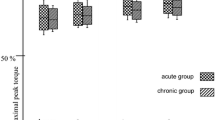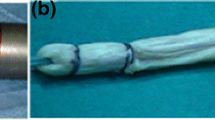Abstract
To evaluate the effects of a rehabilitation brace locked in extension for the first week on the recovery of full extension after ACL reconstruction we compared two groups of subjects who underwent ACL bone-patellar tendon-bone reconstruction. The brace was unlocked twice a day for assisted physiotherapy. In Group A, 18 male subjects wore a post-operative brace locked from 0° to 90°. In Group B, 18 male subjects wore the same post-op brace locked in full extension for the first week. In both groups the brace was unlocked (0°-120°) at the beginning of the second postoperative week, and then removed at the beginning of the third week. All the subjects followed the same rigorous, accelerated rehabilitation protocol. Each subject was evaluated pre and post-operatively (at second, fourth and eighth week) with bubble-level heel height difference (HHD) measurements and KT 1000 arthrometric assessment at the fourth postoperative month. Preoperative bubble-level HHD measurements of the two groups were statistically similar (Group A 0.6 cm, Group B 1 cm; not significant, n.s.). At the fourth week (Group A 2.2 cm, Group B 0.6 cm) and eighth week (Group A 1.6 cm, Group B 0.1 cm) follow-ups, bubble-level HHD measurements showed that the extension of the operated knees of Group B was significantly greater than in Group A. KT 1000 arthrometric scores showed no difference between the two groups (Group A 1.8 mm, Group B 1.5; n.s.).

Similar content being viewed by others
References
Brandsson S, Faxen E, Kartus J (2001) Is a knee brace advantageous after anterior cruciate ligament surgery? A prospective, randomised study with a two-year follow-up. Scand J Med Sci Sports 11:110–114
Campbell JD (1998) The evolution and current treatment trends with anterior cruciate, posterior cruciate and medial collateral ligament injuries. Am J Knee Surg 11:128–135
Cosgarea AJ, Sebastianelli WJ, De Haven KE (1995) Prevention of arthrofibrosis after anterior cruciate ligament reconstruction using the central third patellar tendon autograft. Am J Sports Med 23:87–92
Dandy DJ, Edwards DJ (1994) Problems in regaining full extension after anterior cruciate ligament reconstruction: does arthrofibrosis exist? Knee Surg Sports Traumatol Arthrosc 2:76–79
Daniel DM, Stone ML, Malcom L et al (1983) Instrumented measurement of ACL disruption. Orthop Res Roc 8:12–17
Delay BS, Smolinski RJ, Wind WM et al (2001) Current practices and opinions in ACL reconstruction and rehabilitation: results of a survey of the American Orthopaedic Society for Sports Medicine. Am J Knee Surg 14:85–91
Feller J, Bertlett J, Chapman S, Delahun M (1997) Use of an extension-assisting brace following anterior cruciate ligament reconstruction. Knee Surg Sports Traumatol Arthrosc 5:6–9
Fu FH, Irrgang JJ, Harner CD (1993) Loss of motion following anterior cruciate ligament reconstruction in the anterior cruciate ligament: current and future concepts. Raven Press, New York, pp 373–380
Kartus J, Stener S, Kohler K et al (1997) Is bracing after anterior cruciate ligament reconstruction necessary? A 2-year follow-up of 78 consecutive patients rehabilitated with or without a brace. Knee Surg Sports Traumatol Arthrosc 5:157–161
Howell SM, Clark JA (1992) Tibial tunnel placement in anterior cruciate ligament reconstructions and graft impingement. Clin Orthop 283:187–195
Irrgang JJ, Harner CD (1997) Recent advances in ACL rehabilitation: clinical factors that influence the program. J Sport Rehabil 6:111–124
Marzo JM, Bowen MK, Warren RF et al (1992) Intraarticular fibrous nodule as a cause of loss of extension following anterior cruciate ligament reconstruction. Arthroscopy 8:10–18
Mikkelsen C. Cerulli G, Eriksson E et al (2002) Abstract book of the 10th congress of European Society of Sports Traumatology, Knee Surgery and Arthroscopy, Rome
Miyasaka KC, Daniel DM, Stone ML et al (1991) The incidence of knee ligament injuries in the general population. Am J Knee Surg 4:3–8
Moller E, Forssblad M, Hansson L et al (2001) Bracing versus nonbracing in rehabilitation after anterior cruciate ligament reconstruction: a randomized prospective study with 2-year follow-up. Knee Surg Sports Traumatol Arthrosc 9:102–108
Petsche TS, Hutchinson MR (1999) Loss of extension after reconstruction of the anterior cruciate ligament. J Am Acad Orthop Surg 7:119–127
Risberg MA, Holm I, Steen H et al (1999) The effect of knee bracing after anterior cruciate ligament reconstruction. A prospective randomized study with two years' follow up. Am J Sports Med 27:76–83
Rubinstein RA, Shelbourne KD, Van Meter CD et al (1995) Effect on knee stability if full hyperextension is restored immediately after autogenous bone-patellar tendon-bone anterior cruciate ligament reconstruction. Am J Sports Med 23:365–368
Sachs RA, Daniel DM, Stone ML et al (1989) Patellofemoral problems after anterior cruciate ligament reconstruction. Am J Sports Med 17:760–765
Schlegel TF, Boublik M, Hawkins RJ, Steadman JR (2002) Reliability of heel-height measurement for documenting knee extension deficits. Am J Sports Med 30:479–482
Shelbourne KD, Wilckens JH, Mollabashy A (1991) Arthrofibrosis in acute anterior cruciate ligament reconstruction: the effect of timing on reconstruction and rehabilitation. Am J Sports Med 19:332–336
Strum GM, Friedman MJ, Fox JM et al (1990) Acute anterior cruciate ligament reconstruction: analysis of complications. Clin Orthop 253:184–189
Acknowledgement
The authors thank Stephen O'Connor for language assistance.
Author information
Authors and Affiliations
Corresponding author
Rights and permissions
About this article
Cite this article
Melegati, G., Tornese, D., Bandi, M. et al. The role of the rehabilitation brace in restoring knee extension after anterior cruciate ligament reconstruction: a prospective controlled study. Knee Surg Sports Traumatol Arthrosc 11, 322–326 (2003). https://doi.org/10.1007/s00167-003-0386-3
Received:
Accepted:
Published:
Issue Date:
DOI: https://doi.org/10.1007/s00167-003-0386-3




